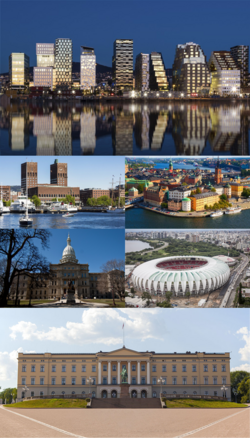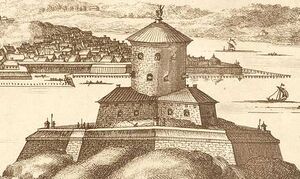Berke
Berke | |
|---|---|
City | |
 Clockwise from top: Berke financial center, Almånbryggen by the Rød river, Rødkysten Stadion, Rødt Presidential Palass, University of Berke's central building, and Berke City Hall. | |
| Nickname(s): Byen av Farger City of Colors | |
| Motto(s): Forente mennesker, sterk by United people, strong city | |
| File:Bfdmap.png | |
| Founded by Sødish natives | 90 CE |
| Government | |
| • Mayor | Jarl Rosten |
| Area | |
| • City | 435,036 km2 (167,968 sq mi) |
| • Urban | 3,194 km2 (1,233 sq mi) |
| Population (2016) | |
| • City | 2,041,749 |
| • Density | 4,693.2/km2 (12,155/sq mi) |
| Demonym | Berkish |
| Time zone | UTC +0 |
| Area code | (+64) 21 |
Berke (Navish Berke pronounced /bæ↘ɾkɛ↗/) is the capital city and second largest city of the United Republic of Navack. Berke is located in the Federal District and it has a population of 2,041,749 as of 2016. Berke is located in southern Navack, occupying a total area of 435,036 km² inside the territory of the state of Kalgnat. The city is divided by both Rød and Blått rivers, dividing it into three main regions: Blåby, Rødby, and Gylnebyen. Aside from functioning as the political centre of Navack, Berke is the main eastern port city in the nation. Berke was renamed after 1921, when the city was still called Kalgnat, the former capital of the United Kingdom of Lhedwin.
History
It is known that the peninsula between the Rød and Blått rivers have been inhabited by the Bærk tribe since before the formation of the Sødish conglomerate. Initially, the village was comprised by fishermen trying to escape from the northland harsh weather. By the end of the BCE era, the locality had become an important hub for fishermen and a pitstop for merchants marching to the north.
Due to the constant transit of merchandise, the fishermen village was soon transformed into a toll city between the southern merchant route and all the rest of the Navish and Glanish territory. By 90 CE, Magnus Kalgnat was the responsible for the construction of the first fortress in the region, the Elvevakt Festning, constructing walls all around the routes and the rivers, creating then a gateway to the north. The region soon enriched due to the taxes payed by merchants and travelers. After Maguns’ death, in 102 CE, the local city assembly decided to name the city after its founder, thus becoming the city of Kalgnat. The city quickly became the largest city in the south, being referred by many as the “Capital of the South.” When all the Sødish tribes united in 268 CE, Kalgnat was elected as the new Capital of the Bærk Kingdom, with King Torleif II being crowned as the first King in the South.
When Navack unified in 847 CE, there was a dispute of where the national capital should be: Harhalsen, the Kirkish capital; Brestrand, the Huskish capital, or Kalgnat, the Bærkish capital. The new National Jarl Council elected Brestrand, but due to local issues, the decision was moved to Kalgnat. The city remained as the national capital, even after the formation of the United Kingdom of Lhedwin, in 1668. However, after the Great War in 1900, and the Navish Revolution of 1921, Kalgnat was renamed due to the taboo created around the name of the former Lhedwinic capital. The national government voted, in 1923, to rename the city from Kalgnat to Berke, as an homage to the Bærkish tribe, founders of the city.
Transport
Twin towns
Berke is twinned or cooperating with several cities, some of which include :
 Graylund, Glanodel
Graylund, Glanodel Vænholm, Glanodel
Vænholm, Glanodel Nebligen, Crylante
Nebligen, Crylante- File:Vrnalliaflag.png Zalejk, Vrnallia
 Större, Motsvara
Större, Motsvara


